
Towards a global language policy for emoji?
An analysis of emoji as an evolving language
If you own a smartphone, and chances are big that you do if you are under the age of 50 in a Western country, you probably are also using emoji, pretty much without thinking too much about them. You have learned how to use them, when to use them and what they add to your otherwise text-based messages. Yet, the world has only been using them (increasingly) extensively over the past decade.
Time to write up a language policy for emoji and start using them in official texts, as well as essays, right? Or is it still a little too soon for the (originally) friendly yellow circular face and its friends to become (part of) a language? What follows is an analysis of emoji, their history, use, meaning, linguistic aspects, and finally an attempt to work towards a language policy for this novel, popular language (or does it even qualify as a language?)
Working towards a global language policy for emoji requires that we have a look at status planning (i.e. what should be their function as a language, or in addition to language?) and corpus planning (codification and standardization). The third aspect of language policy, which is acquisition planning (i.e. who should learn to use the language?), goes beyond the scope of this paper. But before we get to that part, we first have to understand where these emoji come from and what they exactly are.
From emoticon to emoji, from America to Japan
Emoji (from the Japanese words for picture (絵, e) and character (文字, moji), and therefore purely coincidentally similar to the word emoticon) have more or less officially been around since 2011, when they were included in the Apple iPhone iOS 2.2 update, which included the Emoji Keyboard (Blagdon, 2013).
However, emoji were not created by Apple, nor did they come into existence with the update of Apple iOS 2.2. Their history dates to prehistoric times, according to archaeologists of the University of Bologna, who found what appears to be the oldest smiley face yet (Daley, 2017). But in more recent times, the smiley gained popularity in the 50s and 60s of the twentieth century, and the smiley that we know today (i.e. the yellow blob with dots as eyes and a curved line for a smile), is being accredited to American graphic artist Harvey Ross Ball, who "...came up with the image in 1963 when he was commissioned to create a graphic to raise morale among the employees of an insurance company after a series of difficult mergers and acquisitions." (Stamp, 2013)
But the smiley does not look that much like the current emoji that we are so often using when communicating on social media. The first emoji symbols were created around 1998 by Shigetaka Kurita, a telecommunications worker from Japan (Danesi, 2017). He, to some extent, had in mind to develop the emoji to be used as a language accessory. Because of the brief way of addressing one another in emails, Japanese texts lost a lot of their seasonal greetings, honorific expressions and lengthy and verbose language (Blagdon, 2013).
"Kurita wanted Japanese Internet and mobile users to be able to communicate in short-form, without losing the expressiveness seen in traditional Japanese written letters." (Scall, 2016)
From the early 00s onwards, these emoji were slowly adopted by different companies, until they gained the popularity that they have nowadays.
“Without a winking smiley or other blatant display of humor, it is impossible to create a parody of fundamentalism that someone won't mistake for the real thing.” (Poe, 2005)
Two important things happened in the meantime.
First, the emoji were adopted by Unicode version 6.0 in October 2010, and "...the characters that were available prior to that were retroactively updated to provide an emoji presentation" (Emojipedia, n.d.). As a result, you and I do not have to send data consuming images over the internet, but send each other encoded characters (Unicode.org, 2017a), a code point that represents an abstract character, which is visualized on our screens in the shape of letters, characters, punctuation marks, spaces, emoji, etc. As a result, we send codes that are being visualized on our devices (Windows, Android, Apple, Google, etc.) by different 'fonts'. Much like the visualization of the Latin alphabet in Arial or Comic Sans is different, which provokes different responses in from person to person, different 'fonts' of emoji also have implications on how they are being read (to which I will return below).
The second important thing that has been happening since the introduction of emoji, is that they seem to be replacing internet slang (i.e. acronyms like LOL, OMG and ROFL). 'LOL', or 'hehe' seem to be replaced (Dimson, 2015) by those emoji from Table 1. As a result, we can see how internet language has been developing over the years, from the acronyms that we used to use, such as ROFL into the stylized picturesque language attributes that we use today. Here we already can see an interesting aspect of corpus planning: how many emoji do we need to come up with, before it is enough to say: now we can express every emotion, every thought in emoji?
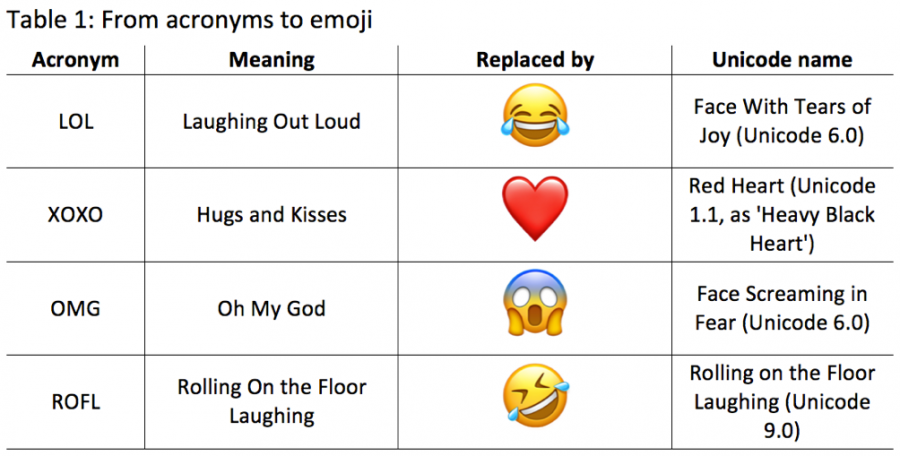
The increase of multimodality
Like many novelty innovations, emoji were seen as less relevant, cute and fun additions to written text in digital communication, but definitely nothing serious. If you are Dutch, you might remember a video about the use of mobile phones. People on the street were interviewed by Frans Bromet in 1998 whether or not they were going to use one. In the video, many people said no, because they did not need or want one.
However, nowadays, almost two-thirds of the world's population owns a mobile phone (Statista, 2018a), with an estimated 36 percent of the world’s population using a smart phone in 2018 (Statista, 2018b). All of these smartphones have the ability to use emoji, and in many cases they are actually being used. Take for example the website emojitracker.com, where the real-time use of emoji on Twitter is being monitored.
At the moment of writing, Face With Tears of Joy has been used over two billion times, followed by Red Heart, Recycling Symbol and Smiling Face with Heart-Eyes (see Table 3). The least frequently used emoji on Twitter, at the moment, is Aerial Tramway, with 123,843 uses (and counting). We can see a connection between emojitracker and word frequency lists that are being used in language education (Filipiak, 2015). By finding the word frequencies in elementary school books and classes, tests are made to test the pupil's language proficiency. By knowing the meaning of the most frequently used emoji, one could maybe also say something about someone's emoji proficiency.
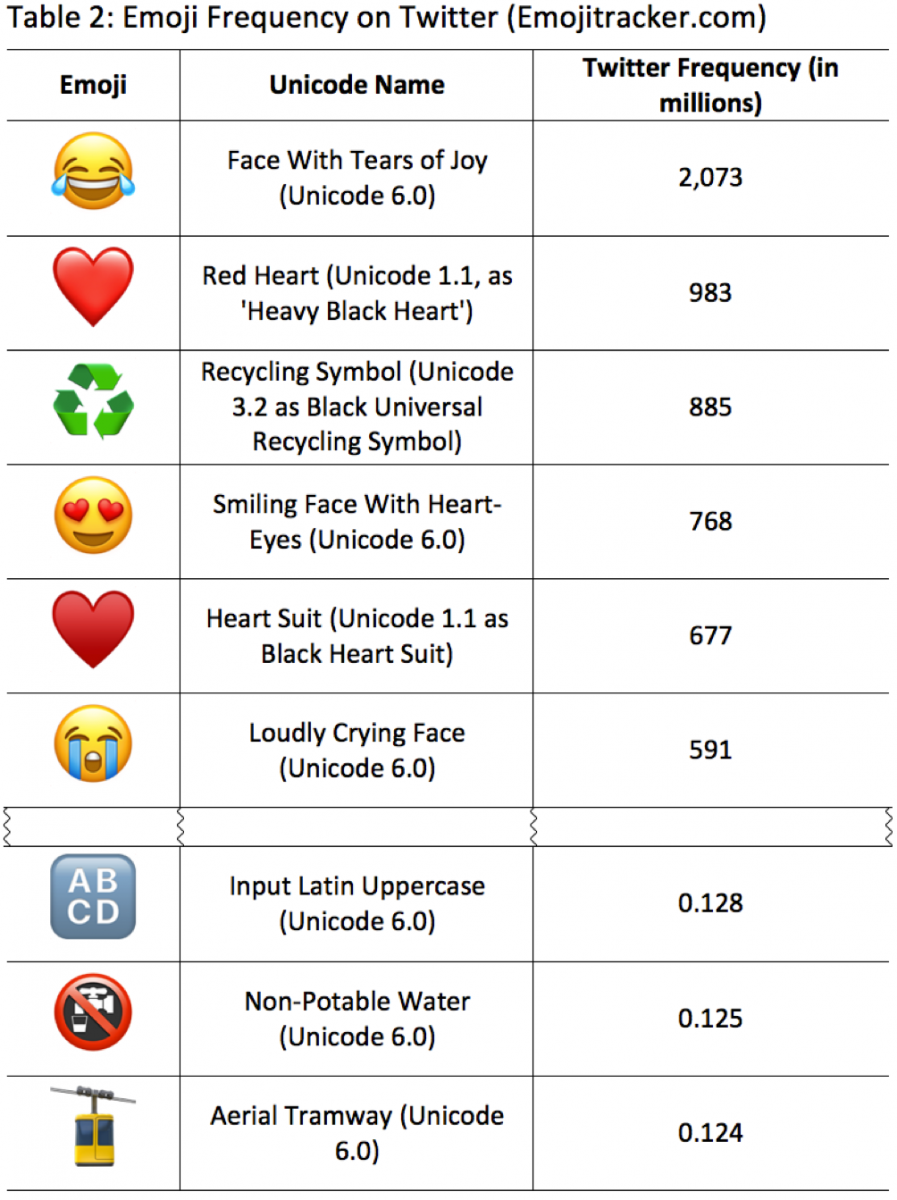
Next to the two billion times that Face With Tears of Joy has been used on Twitter, one can only fathom how often it is used on other social media platforms, such as Facebook, WhatsApp and Instagram. From the latter platform, we have access to some insights. The use of emoji on Instagram exploded when the keyboard was introduced in 2011, and rose to around 40 percent in 2015 (Dimson, 2015). According to an analysis of 20,000 Instagram profiles and 6.2 million posts, performed by Tilo Kmieckowiak and published November 2017, the percentage of Instagram accounts that actually use emoji rose to 56.5 percent. He also found that posts that make use of at least one emoji can lead to 47.7% more interactions than those posts that make no use of emoji at all (Kmieckowiak, 2017).
One of the main reasons that emoji seem to be used, is to put emotional emphasis on messages that are being spread through an otherwise emotionless medium.
“Textspeak – the messages and posts we produce using text and which are transmitted electronically via messaging and social media applications – seemingly possesses the power to strip all forms of nuanced expression from even the best of us.” (Evans, 2017)
Thanks to emoji it is possible to replace the multimodal communicative signals that we use in face-to-face (F2F) interaction – to a certain extent – and as a result improve the way we conduct our messages over the internet through mainly text-based mediums. Multimodality refers to the different modes that “…offer different potentials for making meaning. These differing potentials have a fundamental effect on the choice(s) of mode in specific instances of communication,” (Kress, 2010)
Next to legal use, emoji also found their way into marketing, education and even into Healthcare
In F2F-communication we use everything that we posses to convey our message. Think of tone, speed, articulation, gestures, posture, movements, etc. With the lack of so many ways to express meaning, a lot of miscommunication has occurred in textspeak between lovers, family, employees, and the like. It has even come so far, that an adage of internet culture has arisen: Poe’s law, named after Nathan Poe, who first wrote it down in a comment on an internet forum about Christianity: “Without a winking smiley or other blatant display of humor, it is impossible to create a parody of fundamentalism that someone won't mistake for the real thing.” (Poe, 2005)
Textspeak is starting to catch up with the repertoire that we put to use in the spoken medium (Evans, 2017), and not just because of the emoji's ability to add at least one extra layer of modality to textspeak. “As the nature and practice of using Emoji continues to develop and evolve, its significance will, it’s safe to say, become less contested. In many ways, this is only the beginning.” Emoji are indications of what the speaker intends to convey (Dressner & Herring, 2010).
And with such a widespread use of emoji, it was only a matter of time before that they became the subject of legal debates (e.g. Scall, 2016), and that they have been used in a court of law "…as evidence about someone’s intended meaning, and thus, as revelatory about someone’s state of mind as verbal statements or admissions" (Danesi, 2017). Next to legal use, emoji also found their way into marketing, education and even into Healthcare (Skiba, 2016). Their existence seems to be becoming ever more important, but this importance also comes with a set of implications.
Not so fond of your font
These implications are at least two-fold, but as we will look at the options for corpus planning for emoji, we will find that there are even more implications. The first implication is one that is visual. Very visual. Like discussed above, an emoji acts very much like a font, but we all know how different Arial and Comic Sans make us feel.
“Unicode-wise they look the same, but across platforms emoji look different. Take for example the Pistol emoji: many [platforms] use a water pistol, but some still use actual pistols. This could lead to huge problems in understanding a message.” (Evans, 2017)
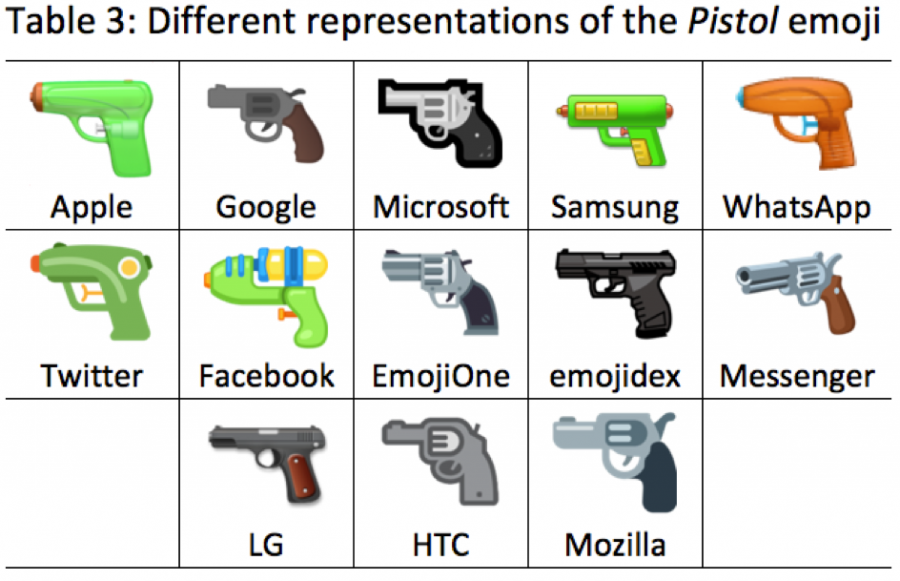
To demonstrate that emoji are not just some frivolous pictures, used by teenagers, I will give two examples: In New Zealand, a judge took the role of emoji in a Facebook message sent by a man to his ex-partner in consideration. The man wrote,
Concluding that the message and emoji generally conveyed that the defendant was “coming to get” his ex-partner, the judge sentenced the accused to 8 months in jail on a charge of stalking” (Kirley & McMahon, 2017).
The reason that the Airplane emoji played an important role in the judge's decision, was the fact that the man had actually booked a plane ticket, although his ex-partner pleaded for him not to come over (New Zealand Herald, 2017). In another example, a Virginian high school student in 2015 shared the following message, which she afterwards claimed to be a joke:

– (Kirley &McMahon, 2017).
It shows how emoji are not at all innocent when used in the wrong way, and how, to some extent at least, Poe's law seems to be justified. “These cases are only increasing,” according to Bradley S. Shear, a Maryland attorney who specializes in Internet issues. “The more people are using their cell phones and posting on the Internet, the more emoji will creep up as evidence in cases.” (Jouvenal, 2016)
But before we start working towards a language policy, we have to understand that next to how they are intended to be read, it is also important to keep in mind that we understand how emoji are interpreted different from culture to culture and even within the same culture, and how they are attributed different meanings. Foss (2005: 150) describes how variation is inevitable, even in the field of visual symbols, because of how they “involve human intervention, and are presented to an audience for the purpose of communicating with that audience.” Danesi (2017) also describes how some emoji keep their core function, while other are more “audience-sensitive”.
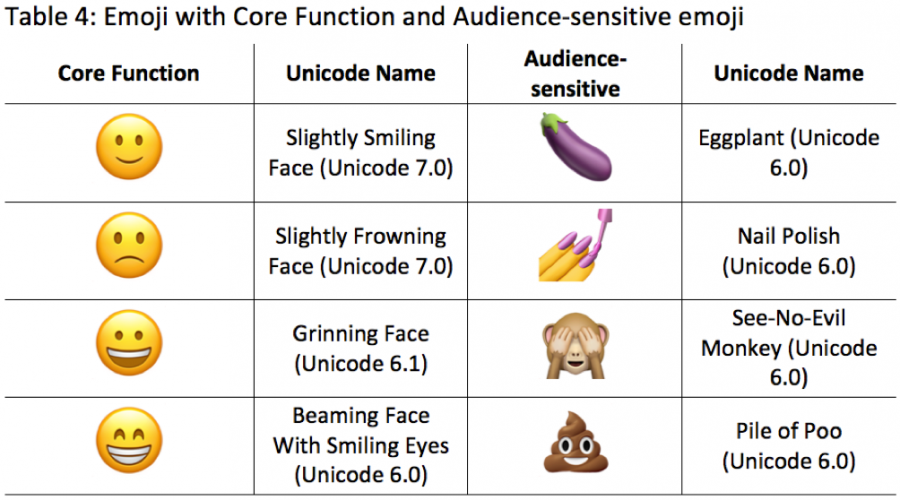
The emoji, such as the Nail Polish emoji have been given different cultural meanings, such as: ‘that was easy’, or a visual symbol for representing classiness. The See-No-Evil Monkey emoji can be "...used as a playful 'I didn’t want to see that' expression (emojipedia.org, n.d.), but it is also widely used to add something like "Oh dear", "Oops", or "Silly me" to a text message, ignoring the original proverbial meaning of the three wise monkeys (Mieder, 1981). And although those with core functions seem to have one meaning only, even this is culturally influenced. To name an example from my own interpretation: I use Beaming Face With Smiling Eyes when saying thanks to someone, or genuinely liking something. But I use Grinning Face when I tell a silly joke that my uncle could have made, while other people use it as a genuine smile.
The latter issue makes it probably difficult to communicate with emoji alone. There have been people trying to do so, case in point: Emoji Dick, which was Fred Benenson's endeavor to translate Melville’s Moby Dick into an emoji-only story. In most cases though, emoji are being used as an addition to written language. But even as a language accessory (Scall, 2016) emoji, even those with a core function, can have different meanings for different people, as I have tried to show with my simple example above.
For emoji to become a globally used and understood language, some form of standardization has to take place. This means that a norm has to be developed, which requires the emoji to go through the process of codification. This includes isolating emoji to determine the norm (i.e. what does a specific emoji actually represent?), followed by an evaluation of the norm it has been given, prescribing the norm in certain contexts, eventually leading to acceptance and use of the norm (Kroon, 2018).
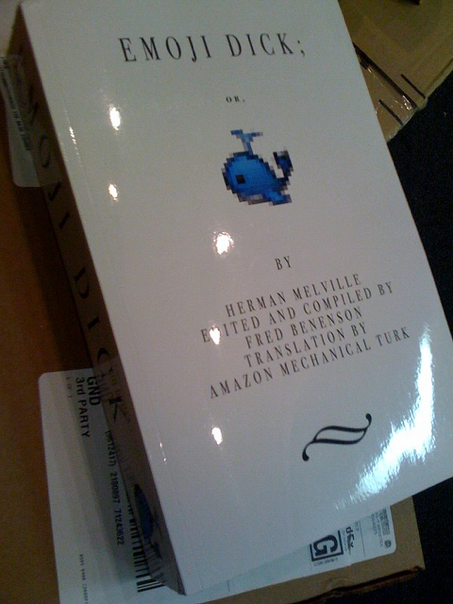
Emoji Dick by Herman Melville, edited and compiled by Fred Benenson
Emoji: language or code?
As emoji are a pretty new tool, at least when it comes to its widespread use, research on it is still picking up slowly, but gaining some momentum in the past few years. Two major books have been published on emoji so far: The Semiotics of Emoji, by Marcel Danesi, and The Emoji Code by Vyvyan Evans (both in 2017).
The first author describes emoji as evolving epigenetically, lining it up with Noam Chomsky’s idea that linguistics is a branch of biology (e.g. Chomsky, 2007: 124). According to Danesi, emoji evolve more like natural languages than other artificial languages: “It is a fluid, organic form of language, and the meanings of emoji symbols are now interpreted differently and applied differently within certain cultures.” (Danesi, 2017)
Evans discusses how emoji is not a language “…in the way that, say, English, French or Japanese are languages; at least not yet” (2017: 17). But he also discusses that “…an emoji is not so different from a word. An emoji is a single meaningful unit deployed in digital, text-based communication" (2017: 76). He then continues that, although the emoji shows ‘impoverished expressiveness’, when comparing it to language, because it is limited in the range of signs, the thing that really keeps it from being a language, is its lack of a grammar system (p.98).
When it comes to its impoverished expressiveness, the simplified Chinese character (jiǎnhuàzì) set is also limited – albeit quite unlimited when one takes into account Unicode provides up to 70,000 Han characters (see the CJK Unified Ideographs by Unicode (2017b), version 10.0), and that Chinese students are supposed to learn nearly 3,000 characters for a basic command of literacy (Hudson-Ross & Dong, 1990).
Still, for many things, different characters are combined to make up a new meaning. Take for example the word for ‘the Netherlands’, which is made up of 荷(pinyin: hé, meaning lotus, or Dutch) and 兰(lán, meaning orchid). Put together, it reads Hélán, which sounds very similar to Holland and with the history of tulips and flowers, the lotus and orchids are not out of place either. Since it is easily possible to further evolve the set of emoji, the biggest setback of being a language, is its lack of grammar (i.e. syntax: "The arrangement of words and phrases to create well-formed sentences in a language." (Oxford Dictionary, 2018)).
Or does it have one? Danesi addresses 19 pages of his book specifically to the grammar of emoji. “[E]moji grammar is not just a replica of linguistic grammar with visual symbols; it has its own “syntactics,” or system for organizing the emoji to create coherent and meaningful sequences or combinations” (2017: 78).
A third linguist that is well-known for his work on emoji, is Terry Schnoebelen. He found that emoji are not just in a jumble, they need to be in a certain order, for “…a different order could convey an entirely different idea or story" (Steinmetz, 2014). Schnoebelen also found that stance (i.e. emotion) comes first, see Table 5.

However, I would contest the 'stance first'-order in the case of the Flexed Biceps and Face With Raised Eyebrow, because 'stance first' would be anatomically incorrect. Another example – of an urban legend – which shows that order is important, but also culturally different, is shown in the advertisement below:

The 'Coca-Cola ad' that failed in Saudi Arabia.
It is not too difficult to see how such an ad would put across a wrong message in Right-To-Left (RTL) languages such as Hebrew, Arabic, Farsi and Urdu. The story goes that an American salesman went to Saudi Arabia to promote his company, but returned after after a marketing disasster, because he did not know that people read from right to left in Saudi Arabia (Qatarliving, 2016). We could do something similar with emoji:
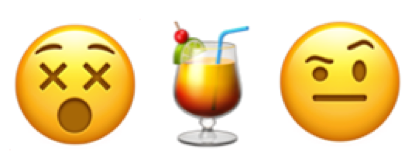
Invigorating drink or cup of hemlock?
In Left-to-Right languages, it looks like the drink in the middle is very invigorating. However, in an RTL language, the drink in the middle looks more like Socrates' cup of hemlock. The video below gives an example of how to avoid this problem, by using emoji that appear chronologically after one another, rather than all together in-line. The order of the emoji in the video clip is important, it tells the story the way it is supposed to be told.
Another point that Danesi makes, is that the emoji actually replace punctuation in some sentences. A dot after an emoji looks weird, the emoji is ‘…a substitute for a period and for the final salutation (2017: 77). So, even though there is no fixed grammar for emoji (yet), it is clear that some grammar exists for a ‘language’, or code if you prefer, that has only been around for less than a decade. In the meantime, Chua (2009) argues: “New forms of communication and communication ‘modification’ will continue to evolve despite the pressures from language policies for standardization.” Above we have seen a few examples of status and corpus planning, but how does one go about making a (preferably global) language policy for emoji?
Towards a (global) language policy for emoji
So far we have learned about the history, the use, the meaning and the semiotics of emoji, whether it being a language or a code. We have seen that its functionality (status) has been spreading to different domains over time, even finding its way into court rooms and into healthcare situations. But before we can continue to create a global language policy for emoji, we have to look deeper into the corpus itself: what do the emoji mean, what do they convey, and how should they be interpreted. In other words: “[H]ow best to develop the form of a language?” (Johnson, 2013). After that it might be possible to start the acquisition (acquisition planning) of more ‘speakers’.
As we have seen, emoji still have long ways to go. In all three of Haugen’s (1983: 275) procedures on corpus planning (i.e. graphization, grammatication as well as lexication), work still needs to be done. I will briefly discuss elements of each of the three procedures described by Haugen.
Graphization: with every new version of Unicode since 2011, new emoji have been introduced, with the introduction of 716 new emoji in version 6.0. Including the emoticons that were available prior to this version, the total grew to 858, and today this number has increased to a total of 1,144 emoji up until 2010. This does not include the different options users have for choosing skin color, for example. And neither does it include the 2018 update to Unicode version 11.0, which will add the number of emoji up to 1,624 (Unicode, 2018). Slightly less characters than the nearly 3,000 that are necessary for basic literacy in Chinese; a small amount of the aforementioned 70,000 Han characters available in Unicode.
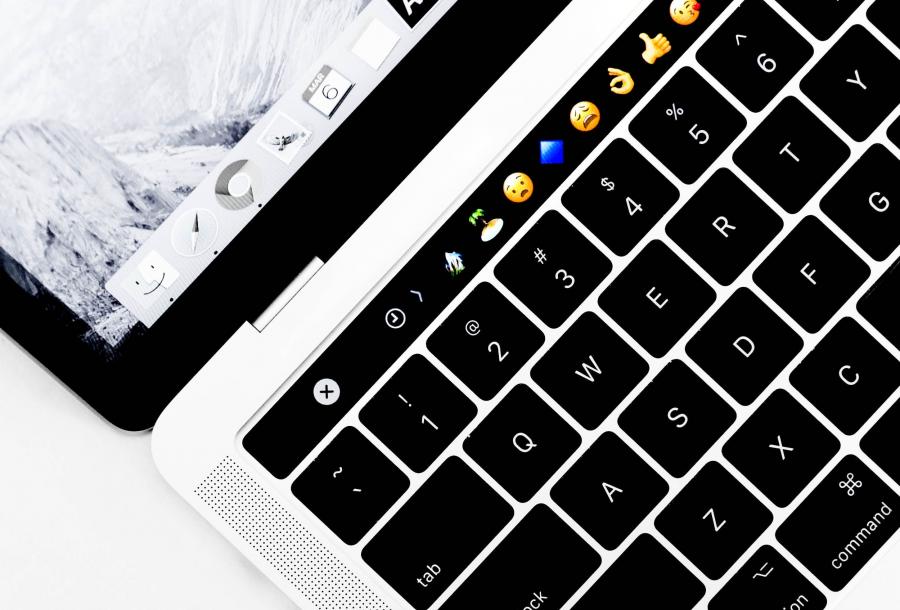
For emoji to be used as a fully developed language, we will need to be able to use more emoji. And there are more 'emoji', because countries have made their own (Hussey, 2015), and there are even Facebook stickers for smaller regions (e.g. Schoenmakers, 2018). There are even applications where you can make your own 'emoji' with apps such as Emojily (App Store, 2018). But these are not recognized by Unicode, and therefore they are often not cross-platform. Furthermore, these types of 'emoji' might be comparable to nonce words, or occasionalisms, lexemes, in our case 'emoji', that are created "...for temporary use, to solve an immediate problem of communication." (Crystal, 1995: 132)
Grammatication: although some form of bottom-up grammar arises for the use of emoji, such as punctuation and the ‘stance first’ use, it lacks a concise set of rules that turn the pictures into a language that is useable across borders. The fact that this does not yet exist makes it especially difficult for communication to go smoothly between people who speak different languages. Above we have seen what the influence of reading right to left versus left to right can be. But the word order is also something to reflect upon, because not every language uses the same order. Most of the languages use either the subject-verb-object (SVO) order or the subject-object-verb (SOV) order, while around a quarter of the world’s languages uses a different order. This might already pose a problem on communicating between languages, the example below could lead to difficulties in interpretation for people who speak a language that is not in the SVO-order, especially if the sentences become more complex. As for the online practices, Novak et al. (2015) found that emoji are most commonly used at the end of a message (on Twitter), showing how a general rule of grammatical use comes into being without the direct intervention of language policy makers.
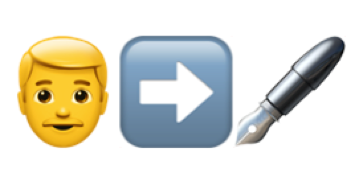
Man gives pen.
Lexicalization: in the case of emoji, in their current state, lexicalization goes hand in hand with graphization. In ‘normal’ alphabetic languages (such as those with the Latin, Greek or Cyrillic script), the graphization is quite finalized, however the lexicon can still be expanded (e.g. by adopting loan words from other languages or new words for new inventions).
In the case of emoji, the words do not need to be invented, they already exist in the different languages in which they can be used. However, as emoji are less adept to handle the abstract (Evans, 2017: 91), it is more difficult to represent words like ‘ambiguous’, ’freedom’ or ‘beauty’. It is not only more difficult to visually represent them, but they might also be subject to cultural – and even personal – differences.
When discussing emoji, there comes a point that the poop emoji has to be mentioned. The friendly smiling Pile of Poo is representing the ‘golden poop’, also known in Japanese as Kin no Unko (Gordenker, 2007), a symbol for good luck. However, outside of the cultural context of Japan, it is probably less likely to be considered to have this meaning. As Danesi (2017: 119) puts it, in Canada it might be interpreted as follows: “Perhaps this reflects a kind of sardonic sense that can be translated as “the world is shitty no matter what” reflecting stereotypically a supposed Canadian hubris based on ironic stoicism.” The problem with lexicalization does not seem to be that we need to find the right words to describe the emoji, but rather what the actual meaning of these characters is.
Arabic speakers used the rose emoji ten times more than other language speakers.
According to Novak et al. (2015), people use emoji in specific ways, but most of the emoji (more than 70 percent) were used to emphasize the (positive) emotion conveyed in the message sent. Within cultures, different emoji were used more than others (Danesi, 2017: 120; SwiftKey, 2015):
- In addition to poop, Canadians and Anglo-American societies generally showed a high degree of usage of money, sports, violence-based, and raunchy emoji.
- Americans in particular used gun, pizza, and drumstick emoji more than anyone else.
- Australians used emoji referring to drugs, alcohol, junk food, and holidays much more than any other nation.
- The French used the heart emoji four times more than anyone else.
- Arabic speakers used the rose emoji ten times more than other language speakers.
- Spanish-speaking Americans used sad faces more than any other group.
Different uses as well as different meanings come with the implication that it is very difficult to create one all-involving language policy for emoji at the moment. But when one looks at emoji from a distance, they start to take on the shape of a pidgin language (Hymes, 1971) in that it has a limited grammar, and people from backgrounds of multiple languages are involved. Pidgins exist out of two or more languages, and are stripped down to its essentials. "Such a heavily simplified language is capable of conveying the basic information needed for many cross-linguistic purposes" (Van Herk, 2012).
Pidgins arise when there is prolonged language contact between people who do not speak the same language, for example during colonial trade, which leads to a very simplified language with only a small set of content words and little grammatical complexity. In a sense, emoji show a lot of resemblance to pidgin: the set of content 'words' is small, and there is little grammatical complexity. Pidgin were initially used in the restricted domain of trade, while emoji are mostly used in the restricted domain of adding context to textspeak. As long as the use of emoji stays restricted like this, it does not need (m)any rules. However, if this way of meaning making becomes more universal, the status and corpus need more planning.
In a sense, emoji show a lot of resemblance to pidgin: the set of content 'words' is small, and there is little grammatical complexity.
Creating a new type of language, i.e. the development of a pidgin into a real language – a creole – takes time, and this might very much be the case with emoji. A creole language is a pidgin language that has evolved into a natural language with native speakers (Muyskens and Smith, 1994).
Looking at how Hymes describes that pidgins were not taken seriously as a language in their early stages of development: “What makes the difference is that linguists have taken up the study of pidgins with the seriousness that hitherto characterized only the investigation of natural languages” (1971: 118), we may find that emoji might be gaining more serious attention from researchers, as they develop into a more complex language and become more solidified in our daily language practices.
If the emoji code, over time, transforms into a new syntactical, lexical and semantic system (i.e. a language), it will receive more attention from language planners and policy makers. Perhaps emoji might even have 'native speakers' in the future, those users who were raised using emoji in their textspeak, making it a global supervernacular, i.e.: "...[a widespread code] used in communities that do not correspond to ‘traditional’ sociolinguistic speech communities, but are deterritorialized and transidiomatic communities that, nonetheless, appear to create a solid and normative sociolinguistic system." (Blommaert, 2012)
Are emoji turning into a global language?
Is that what emoji are turning into? For now, it is hard to tell whether emoji are destined to remain a language accessory, or that we have witnessed the birth of a global supervernacular, since their existence is still in an early stage and their development is still moving fast. However, the small icons seem to become embraced more and more by the people that use them, a potential user base that by now has grown to over two billion people. For that reason alone, emoji cannot be ignored.
The question that arises though, is whether emoji is already ready for a language policy to be developed around them. Maybe they should first keep developing like a pidgin, where they are used from a bottom-up perspective, led top-down by Unicode when it comes to their availability. On the other hand, it is important to keep in mind that emoji do not have to replace any language, but that they can do just fine in helping us add context and emotion to our text-based communication style in our own language(s) in the digital era. In that case, they do not necessarily have to evolve beyond a language accessory (Scall, 2016).
As digital communication keeps on developing, it is possible that we stay dependent on our text-based style of communication. But who knows what the future might bring, maybe we will keep typing, maybe textspeak will be replaced by more convenient digital audiovisual communication devices. The fact that emoji are being used so frequently nowadays, is a blessing for those who had a hard time interpreting emotionless texts from significant others, and it shows that we can go beyond F2F-communication to convey messages the way we want them to be conveyed. However, bodily gestures and other aspects of F2F-communication still make up for a more wholesome communicative display, it shows that digital communication is on its way of becoming an integral part of our communicative repertoires as well.

Hopefully for the good of human kind
References
Blagdon, J. (2013). How Emoji Conqured the World.
Blommaert, J. (2012). Supervernaculars and their dialects. Dutch Journal of Applied Linguistics, 1(1), pp. 1-14.
Bromet, F. (1998). Mobiel Bellen in 1998 door Frans Bromet.
Johnson, D.C. (2013). Language Policy. New York, USA: Palgrave Macmillan.
Chomsky, N. 2007. On Language. New York, USA: The New Press.
Crystal, D. (1995). The Cambridge Encyclopedia of the English Language. Cambridge, UK: Cambridge University Press.
Daley, J. (2017). World's Oldest Smiley Face May Decorate a Hittite Jug.
Danesi, M. (2017). The Semiotics of Emoji. London, UK: Bloomsbury Academic.
Dimson, T. (2015). Emojineering Part 1: Machine Learning for Emoji Trends.
Dresner, E., and Herring, S. C. 2010. Functions of the nonverbal in CMC: Emoticons and illocutionary force. Communication Theory 20(3):249–268.
Emojipedia.org (n.d.) See-No-Evil Monkey.
Evans, V. (2017). The Emoji Code. London, UK: Michael O’mara Books Limited.
Filipiak, P. (2015). Onduidelijk wat de Cito-woordenschattoets meet: woorden, kinderen of leraren.
Foss, S. K. (2005). “Theory of Visual Rhetoric.” In Smith, K., Moriarity, S., Barbatsis, G. & Kenney, K. (eds.), Handbook of Visual Communication: Theory, Methods, and Media, 141–52. London, UK: Routledge.
Gordenker, A. (2007). Gold Poop.
Haugen, E. (1983). The implementation of corpus planning: Theory and practice. In J. Cobarrubias and J.A.Fishman (eds.) Progress in Language Planning: International Perspectives. Berlin, Germany: Mouton de Gruyter.
Herk, G. van. (2012). What Is Sociolinguistics. West Sussex, UK: John Wiley & Sons Ltd.
Hudson-Ross, S., Dong, Y. R. (1990). Literacy Learning as a Reflection of Language and Culture: Chinese Elementary School Education. The Reading Teacher 44 (2). pp.110–123.
Hymes, D. (1971). Pidginization and Creolization of Languages. Cambridge.UK: Cambridge University Press
Jouvenal, J. (2016). A 12-year-old girl is facing criminal charges for using certain emoji. She’s not alone.
Kirley, E., McMahon, M. (2017). How the law responds when emoji are the weapon of choice.
Kmieckowiak, T. (2017). Use of Emojis Can Lead to 47.7% More Interactions on Instagram.
Kress, G. 2010. Multimodality: A Social Semiotic Approach to Contemporary Communication. Abingdon, UK: Routledge.
Kroon, S. (2018, May 30). LP 3 [PowerPoint].
Mieder, W. (1981). The Proverbial Three Wise Monkeys. Midwestern Journal of Language and Folklore 7. pp. 5–38.
Muyskens, P., Smith, N. (1994). The study of pidgin and creole languages. pp. 3–8. in Arends J., Muyskens, P., Smith, N. (eds.) Pidgins and Creoles. An Introduction.Amsterdam, the Netherlands: John Benjamins B.V.
Novak, P. K., Smailović, J. Sluban, B. Mozetič, I. (2015). Sentiment of Emojis. PLoS ONE 10 (12): e0144296. doi:10.1371/journal.pone.0144296
Oneohtrix Point Never. (2013). Boring Angel.
Oxford Dictionary. (2018). Syntax.
Poe, N. (2005). Big Contradictions in the Evolution Theory.
Qatarliving. (2016). A Marketing Disaster.
Scall, R. (2016). Emoji As Language and Their Place Outside American Copyright Law. The NYU Journal of Intellectual Property & Entertainment Law, (5) 2. pp.381–405.
Siew Kheng Catherine Chua (2009) A new concept of ‘bilingualism’ for the IT age, Current Issues in Language Planning, 10:4, 442-455, DOI: 10.1080/14664200903554982.
Skiba, D. J. (2016). Face with Tears of Joy Is Word of the Year: Are Emoji a Sign of Things to Come in Health Care? Nursing Education Perspectives: January/February 2016, 37 (1). p.56-57.
Stamp, J. (2013). Who Really Invented the Smiley Face?
Statista (2018a). Number of mobile phone users worldwide from 2013 to 2019 (in billions).
Statista (2018b). Number of smartphone users worldwide from 2014 to 2020 (in billions).
Steinmetz, K. (2014). Here Are Rules of Using Emoji You Didn’t Know You Were Following.
SwiftKey. (2015). Most-used emoji revealed: Americans love skulls, Brazilians love cats, the French love hearts.
Unicode. (2017a). Glossary of Unicode Terms.
Unicode. (2017b). CJK Unified Ideographs.
Unicode. (2018). Emoji Counts, v11.0.